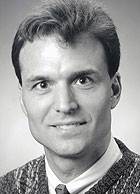As new drugs have dramatically reduced death rates among people with HIV infection, those patients have developed other complications, such as cardiovascular disease, at very high rates.
Over the summer, several Washington University researchers convened with other scientists from around the country for a State of the Science Conference to discuss ways to decrease cardiovascular risk and increase the quality of care for patients living with HIV/AIDS. The conference was a joint effort of the American Heart Association and the American Academy of HIV Medicine.

Among other key findings, the group reported that the risk for heart attack is 70 percent to 80 percent higher among people with HIV compared with those who do not have HIV. They also reported that having HIV is associated with increases in two important risk factors for heart disease: low levels of HDL cholesterol (high-density lipoproteins, the so-called “good” cholesterol) and elevated levels of triglycerides.
Kevin E. Yarasheski, Ph.D., professor of medicine, of cell biology and physiology and of physical therapy, said the conference laid the groundwork for future research. The scientists noted that many HIV-infected patients have cholesterol abnormalities, insulin resistance, diabetes, excess abdominal weight and other risk factors, which may be side effects of antiretroviral medications, effects of the virus or both.
“Some of this may be influenced by the HIV drug regimen, but some may be caused by the virus itself,” Yarasheski said.
W. Todd Cade, Ph.D., assistant professor of physical therapy; Victor G. Davila-Roman, M.D., professor of medicine; Paul Hruz, M.D., Ph.D., assistant professor of pediatrics; Turner Overton, M.D., assistant professor of medicine; Linda R. Peterson, M.D., associate professor of medicine; and Dominic Reeds, M.D., assistant professor of medicine, were the other WUSTL researchers who participated. Yarasheski said future research must determine what happens at the molecular level that causes these increases inrisk.
“Often the risk factors are the same,” he said. “Diabetes, insulin resistance and obesity cause problems for people who aren’t HIV positive, too. But the evidence suggests that having HIV as well as these cardio-metabolic risk factors is a bit more risky than not having HIV and still being obese or diabetic. The hypothesis we’re going to test is whether and how HIV, by itself, adds risk.”
Yarasheski said because HIV is a chronic infection, it increases inflammation in the body, and over the course of months and years, inflammation is known to be bad for the heart and the blood vessels. That may be one reason for increased risk in HIV-infected people. He said it’s also possible that the virus causes the heart to use energy differently. But those ideas require further study. One strategy, however, that could dramatically lower risk immediately involves tobacco.
“Finding ways to curtail smoking in the HIV population would probably have the biggest impact on reducing cardiovascular disease,” he said. “Forty to 50 percent of the people with HIV use tobacco, and tobacco is a major risk factor. So smoking cessation may be step No. 1. Then we can start thinking about the other factors that increase cardiovascular risk in these patients.”